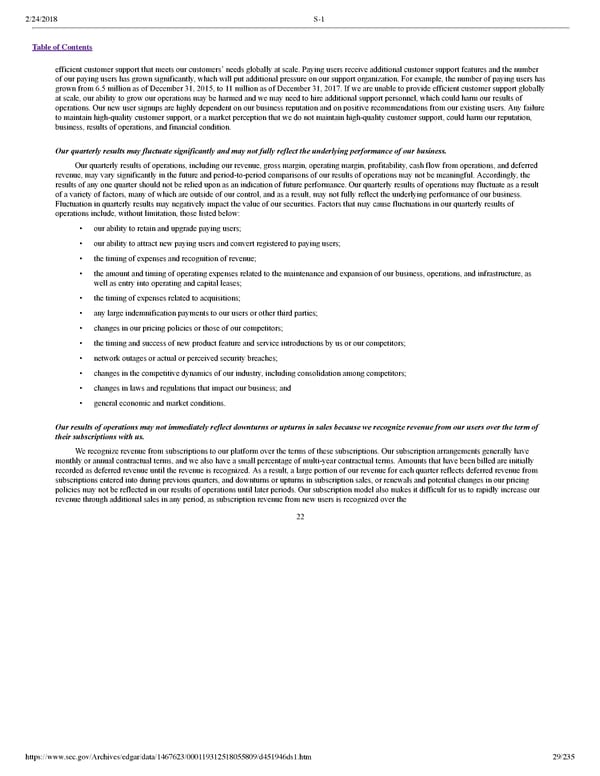2/24/2018 S-1 Table of Contents efficient customer support that meets our customers’ needs globally at scale. Paying users receive additional customer support features and the number of our paying users has grown significantly, which will put additional pressure on our support organization. For example, the number of paying users has grown from 6.5 million as of December 31, 2015, to 11 million as of December 31, 2017. If we are unable to provide efficient customer support globally at scale, our ability to grow our operations may be harmed and we may need to hire additional support personnel, which could harm our results of operations. Our new user signups are highly dependent on our business reputation and on positive recommendations from our existing users. Any failure to maintain highquality customer support, or a market perception that we do not maintain highquality customer support, could harm our reputation, business, results of operations, and financial condition. Our quarterly results may fluctuate significantly and may not fully reflect the underlying performance of our business. Our quarterly results of operations, including our revenue, gross margin, operating margin, profitability, cash flow from operations, and deferred revenue, may vary significantly in the future and periodtoperiod comparisons of our results of operations may not be meaningful. Accordingly, the results of any one quarter should not be relied upon as an indication of future performance. Our quarterly results of operations may fluctuate as a result of a variety of factors, many of which are outside of our control, and as a result, may not fully reflect the underlying performance of our business. Fluctuation in quarterly results may negatively impact the value of our securities. Factors that may cause fluctuations in our quarterly results of operations include, without limitation, those listed below: • our ability to retain and upgrade paying users; • our ability to attract new paying users and convert registered to paying users; • the timing of expenses and recognition of revenue; • the amount and timing of operating expenses related to the maintenance and expansion of our business, operations, and infrastructure, as well as entry into operating and capital leases; • the timing of expenses related to acquisitions; • any large indemnification payments to our users or other third parties; • changes in our pricing policies or those of our competitors; • the timing and success of new product feature and service introductions by us or our competitors; • network outages or actual or perceived security breaches; • changes in the competitive dynamics of our industry, including consolidation among competitors; • changes in laws and regulations that impact our business; and • general economic and market conditions. Our results of operations may not immediately reflect downturns or upturns in sales because we recognize revenue from our users over the term of their subscriptions with us. We recognize revenue from subscriptions to our platform over the terms of these subscriptions. Our subscription arrangements generally have monthly or annual contractual terms, and we also have a small percentage of multiyear contractual terms. Amounts that have been billed are initially recorded as deferred revenue until the revenue is recognized. As a result, a large portion of our revenue for each quarter reflects deferred revenue from subscriptions entered into during previous quarters, and downturns or upturns in subscription sales, or renewals and potential changes in our pricing policies may not be reflected in our results of operations until later periods. Our subscription model also makes it difficult for us to rapidly increase our revenue through additional sales in any period, as subscription revenue from new users is recognized over the 22 https://www.sec.gov/Archives/edgar/data/1467623/000119312518055809/d451946ds1.htm 29/235
 Dropbox S-1 | Interactive Prospectus Page 28 Page 30
Dropbox S-1 | Interactive Prospectus Page 28 Page 30